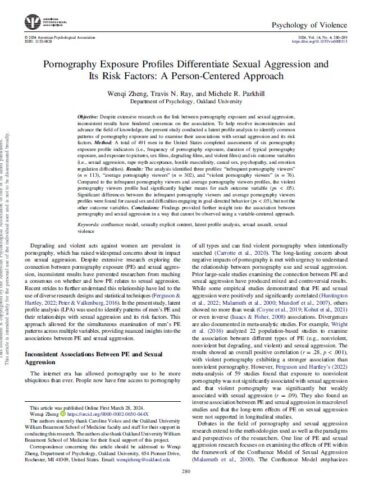Violence
Pornography exposure profiles differentiate sexual aggression and its risk factors: A person-centered approach.
Open Access: No.
Abstract
Pornography use has become widespread and mainstream in American society, with estimates that 60% of men and 35% of women have viewed pornography at some time in the last year. Pornography use has been associated with both positive and negative outcomes depending on the user, and some of these conflicting results may stem from problematic measurement. Using a newly validated measure that assesses frequency, duration, arousal, and deliberate or accidental exposure to seven common types of pornography, we sought to understand whether the motivations to view pornography differed depending on biological sex of the user and the type of use they engaged in. With an MTurk.com sample of 312 participants, we used a variable selection to explore the most consistent predictors of pornography use. Results found that sexually based motivations were consistent motivations to use pornography for both males and females. Educationally based motivations reliably predicted accidental exposure to pornography, while emotions like sadness and tiredness reliably predicted longer durations of pornography use. These results indicate that motivations to view pornography are similar for males and females and that sexually based reasons and emotions are primary in an individual’s decision to use pornography.
Relevance
The study defined degrading pornography as depictions of women in a degrading role, a submissive role, or showing a man ejaculating on the face or body of his partner. Violent films were defined as involving “violent sex [e.g., rape].”
Viewers of violent pornography had “significantly higher” scores compared to infrequent and “average” viewers for sexual aggression, rape myth acceptance, hostile masculinity, casual sex, psychopathy, and emotion regulation difficulties. They “had increased severity of sexual aggression perpetration.” The consumption of violent pornography seems to “further reinforce harmful violence-related or gender-based cognitions (e.g., hostility toward women), thus increasing the risk of sexual aggression perpetration.”
Citation
Zheng, W., Ray, T. N., & Parkhill, M. R. (2024). Pornography exposure profiles differentiate sexual aggression and its risk factors: A person-centered approach. Psychology of Violence, 14(4), 280–289. https://doi.org/10.1037/vio0000513

